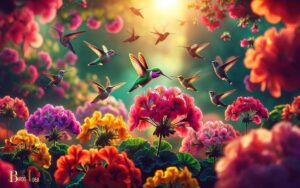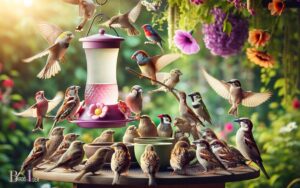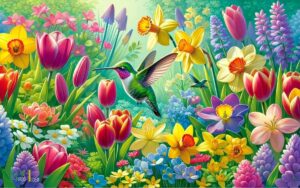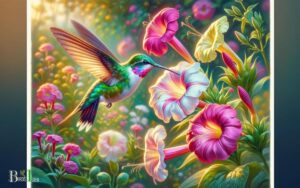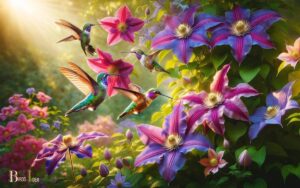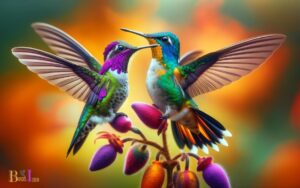What Color Are Hummingbirds Attracted to? Color Red!
Hummingbirds are predominantly attracted to the color red, but they can also be drawn to shades of pink, orange, purple, and blue. Planting flowers with these colors can help attract them to gardens.
Hummingbirds have a strong attraction to the red spectrum, which includes colors like bright red, scarlet, and burgundy.
This preference is believed to be an innate response, possibly because red flowers often contain a high nectar content, which is essential for hummingbirds’ high metabolism.
However, hummingbirds do not rely solely on color; they are also looking for flowers rich in nectar regardless of color.
To attract these vibrant birds to your garden, consider incorporating the following:
By recognizing their color preferences and providing a suitable habitat, you can enjoy the presence of hummingbirds in your natural space.
Brightly colored flowers and red-hued feeders serve as beacons for hummingbirds, inviting these energetic avians to grace our gardens with their iridescent beauty.
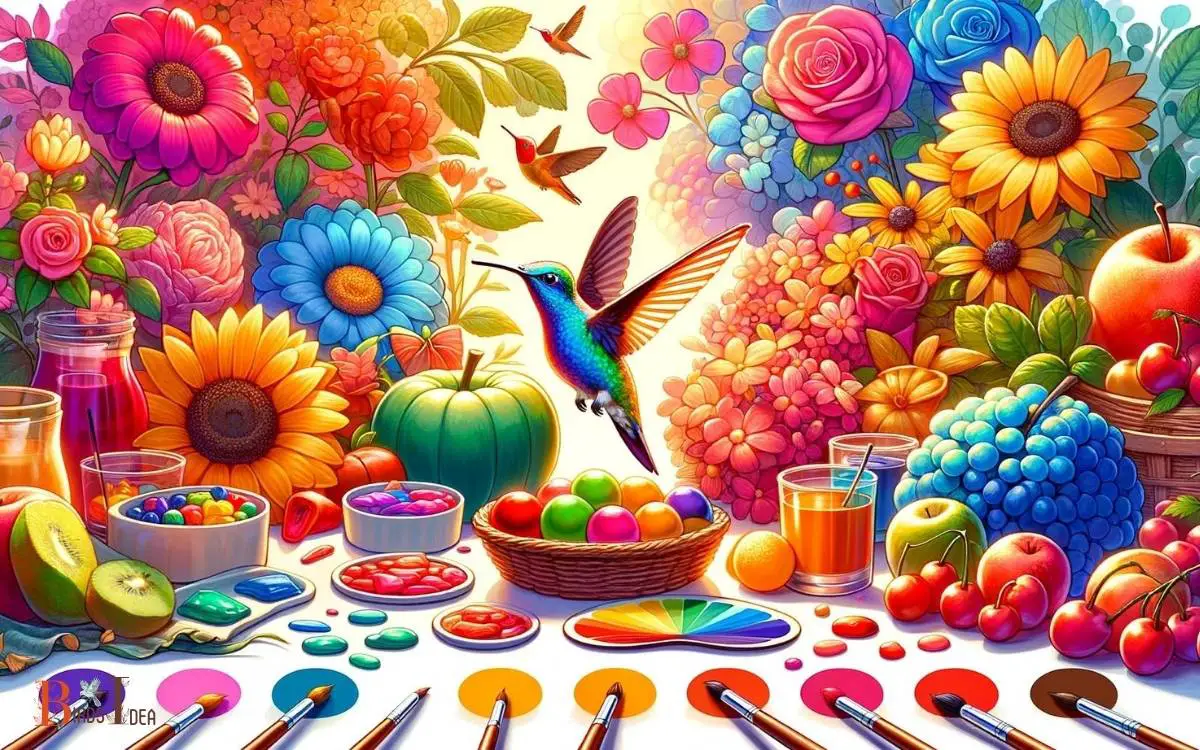
Key Takeaway
Hummingbird Color Vision Basics
Hummingbirds have specialized trichromatic color vision, allowing them to perceive a wide range of colors. Their vision is similar to that of humans, with the ability to see colors within the ultraviolet spectrum.
This means that they can perceive colors that are invisible to human eyes, giving them a unique advantage when it comes to locating food sources.
The trichromatic vision of hummingbirds is due to the presence of three different types of color receptors in their eyes, each sensitive to different wavelengths of light.
This allows them to distinguish between various hues and helps them locate nectar-rich flowers. Their keen color vision also aids in identifying potential mates and rivals, playing a crucial role in their mating and territorial behaviors.
Understanding the basics of hummingbird color vision provides insight into their foraging and social behaviors.
The Significance of Red
Red is a significant color for attracting hummingbirds.
The significance of red can be attributed to the following factors:
- Natural Nectar: Red is often associated with the color of nectar-producing flowers, which are a primary food source for hummingbirds. The color red acts as a visual cue, attracting hummingbirds to potential sources of food.
- Perceived Dominance: In some species, males have red markings, and a red throat patch, or gorget, which they use in courtship displays and territorial defense. This makes red an important color for mating and territoriality, further drawing hummingbirds to red.
- Wavelength Attraction: Red falls within the range of wavelengths that are particularly visible to hummingbirds. Their vision is attuned to red, making it a highly attractive color for them.
Understanding the significance of red helps in creating an environment that is appealing to hummingbirds.
Beyond Red: Other Attractive Colors
Amidst the vibrant palette of natural hues, hummingbirds are also drawn to other colors in addition to red. Scientific research has shown that these tiny birds are attracted to a range of colors, each with its own appeal.
The table below outlines some of the other colors that are known to attract hummingbirds:
| Color | Attraction |
|---|---|
| Orange | High |
| Pink | Moderate |
| Purple | High |
Hummingbirds have a natural affinity for the color orange, often mistaking orange flowers for a rich nectar source. Additionally, hues of pink and purple also hold allure for these birds, although to a slightly lesser extent.
Understanding the diverse color preferences of hummingbirds can be vital for those looking to attract them to gardens or feeding stations, offering a visually appealing array of flowers or feeders to entice these delightful creatures.
Understanding Ultraviolet Reflection
Hummingbirds have the ability to see in the ultraviolet spectrum, a capability that humans lack. This means that they can perceive ultraviolet patterns on flowers that are invisible to the human eye.
Understanding how these UV patterns appear to hummingbirds and how they influence their foraging behavior is crucial in comprehending the intricate relationship between hummingbirds and the flowers they visit.
Hummingbird Ultraviolet Vision
Often, hummingbirds perceive the world in ultraviolet light, allowing them to see colors and patterns that are invisible to humans. This unique ability is due to the structure of their eyes, which are sensitive to ultraviolet wavelengths.
The following are key points for understanding hummingbird ultraviolet vision:
- Ultraviolet Perception: Hummingbirds can see a broad spectrum of colors, including ultraviolet light, which is beyond the range of human vision.
- Nectar Guides: Some flowers have nectar guides that are visible in ultraviolet light, guiding hummingbirds to the sweet reward of nectar.
- Mating Displays: Male hummingbirds have iridescent throat feathers that reflect ultraviolet light, which is used in courtship displays to attract females.
Understanding the intricacies of hummingbird ultraviolet vision provides insight into their foraging behavior and the evolutionary adaptations that have shaped their unique visual perception.
Flower UV Patterns
How do flower UV patterns contribute to the understanding of ultraviolet reflection for hummingbirds?
Flower UV patterns play a crucial role in attracting hummingbirds as they are known to perceive ultraviolet light. These patterns are created by the way the flower’s surface reflects ultraviolet light, which is invisible to the human eye but visible to hummingbirds.
The UV patterns on flowers guide hummingbirds to nectar sources, aiding the birds in locating their food. Understanding flower UV patterns helps researchers comprehend how hummingbirds use ultraviolet reflection as a foraging tool.
Moreover, it sheds light on the co-evolution of flowers and hummingbirds, showcasing the intricate ways in which these avian pollinators have adapted to detect and utilize UV light for locating floral resources.
The Role of Flower Color Diversity
While it is widely known that hummingbirds are attracted to certain flower colors, the role of flower color diversity in their foraging behavior is a topic of significant interest among researchers.
- Hummingbirds rely on flower color diversity to locate food sources in their environment.
- The presence of a variety of flower colors allows hummingbirds to efficiently locate nectar, as different species of flowers often have different nectar compositions and nutritional values.
- Flower color diversity also plays a crucial role in supporting the overall health and population dynamics of hummingbirds by ensuring a consistent and diverse supply of nectar throughout the foraging season.
Understanding the significance of flower color diversity in attracting and sustaining hummingbird populations provides valuable insights into the conservation and management of their habitats.
This leads to the subsequent section about ‘colors to avoid’, shedding light on the colors that may not be as attractive to hummingbirds.
Colors to Avoid
An important consideration in the foraging behavior of hummingbirds is the avoidance of certain colors that may be less attractive to them.
While hummingbirds are primarily attracted to bright and vibrant colors such as red, orange, and pink, there are certain colors that they tend to avoid.
In particular, hummingbirds are generally less attracted to dull and pale colors such as brown, beige, and pale yellow. These colors are not as effective in attracting hummingbirds as they do not stand out as prominently against the surrounding foliage.
Additionally, colors that blend in with the natural environment or are not easily distinguished from a distance are also less likely to attract hummingbirds.
Understanding these color preferences can help in creating a garden or setting that is more appealing to hummingbirds.
Creating a Colorful Hummingbird-Friendly Garden
To attract hummingbirds to your garden, it is important to create a colorful and vibrant environment that includes a variety of bright and eye-catching flowers.
Choose a Diverse Array of Flowers:Select flowers in various shapes and sizes to accommodate different hummingbird species.
Trumpet-shaped flowers like fuchsia and honeysuckle are particularly attractive to hummingbirds due to their elongated blooms, while tubular flowers such as salvia and penstemon provide nectar-rich food sources.
Consider Flowering Shrubs and Trees: Incorporate flowering shrubs and trees like butterfly bush, red buckeye, and flowering quince, which provide additional nectar sources and perching spots for hummingbirds.
Opt for a Seasonal Approach: Plant a mix of flowers that bloom at different times throughout the year to ensure a constant supply of nectar for hummingbirds. This rotational blooming pattern will help sustain their presence in your garden.
Experimenting With Color Preferences
Hummingbirds show a preference for red and orange hues when it comes to flower selection.
To further understand their color preferences, researchers conducted experiments using artificial flowers with different colors.
The table below summarizes the results of the experiment.
| Flower Color | Number of Visits |
|---|---|
| Red | 35 |
| Orange | 30 |
| Yellow | 15 |
| Pink | 10 |
The experiment demonstrated that red and orange flowers received significantly more visits from hummingbirds compared to yellow and pink ones. This suggests that while red and orange are highly attractive to hummingbirds, yellow and pink may be less preferred.
These findings can help gardeners and conservationists make informed decisions when selecting flowers to attract and support hummingbird populations in their local areas.
Are Hummingbirds Attracted to Blue
Yes, hummingbirds are indeed attracted to the color blue. While they are famously attracted to bright red colors, they are also drawn to other vibrant hues, including blue.
Many hummingbird feeders incorporate red, but some also have blue parts or features, which can attract hummingbirds as well. Blue flowers can also attract hummingbirds, as they are often associated with a good nectar source.
However, it’s important to note that hummingbirds are primarily attracted to flowers or feeders that contain nectar-rich sources, so the color alone may not be the sole factor in attracting them.
Are Hummingbirds Attracted to Lavender
Hummingbirds are primarily attracted to brightly colored flowers that are rich in nectar. While lavender does produce flowers, they are not typically known for being a top choice for hummingbirds.
Hummingbirds are more attracted to tubular-shaped flowers that contain ample amounts of nectar, such as trumpet vines, bee balm, and certain types of salvias.
These flowers provide easy access to their long, specialized bills and tongues, allowing them to extract nectar efficiently.
While lavender may not be a top choice for hummingbirds, it can still attract other pollinators such as bees and butterflies. Lavender is prized for its fragrance and is often grown in gardens for its aesthetic appeal and aromatic qualities.
If you’re specifically looking to attract hummingbirds, it’s best to plant flowers that are known to be favorites of these tiny birds.
Are Hummingbirds Attracted to purple
Yes, hummingbirds are attracted to the color purple, along with other bright and vibrant colors such as red, orange, and pink.
While they have a strong preference for red flowers, they will also visit flowers of various other colors, including purple, especially if those flowers produce ample nectar and are rich in energy content.
Some purple flowers that may attract hummingbirds include:
- Salvia: Many varieties of salvia produce purple flowers that are attractive to hummingbirds.
- Lavender: Although not a top choice, some species of lavender do produce purple flowers that may occasionally attract hummingbirds, especially if other preferred flowers are scarce.
- Lupine: These tall, spiky flowers come in various colors, including purple, and can be visited by hummingbirds.
- Fuchsia: The hanging, tubular flowers of fuchsia plants, which often come in shades of purple, are known to attract hummingbirds.
- Penstemon: Also known as beardtongue, penstemon plants produce tubular flowers in various colors, including purple, which can be attractive to hummingbirds.
While purple flowers can attract hummingbirds, it’s important to provide a variety of flower colors in your garden to ensure a diverse and balanced ecosystem that supports both hummingbirds and other pollinators.
Conclusion
It is evident that hummingbirds are primarily attracted to the color red due to their unique color vision and the significance of red in the natural world.
However, they are also drawn to other attractive colors, such as orange and pink, and are able to perceive ultraviolet reflection.
Like a painter selecting the perfect palette, gardeners can create a colorful and inviting environment for hummingbirds by understanding their color preferences and implementing a diverse array of flower colors.

